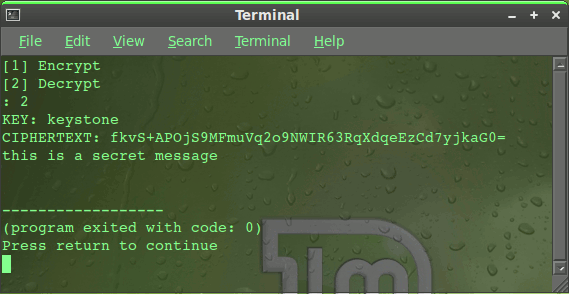AES allows for three different key lengths: 128, 192, or 256 bits. Most of our discussion will assume that the key length is 128 bits. With regard to using a key length other than 128 bits, the main thing that changes in AES is how you generate the key schedule from the key — an issue I address at the end of Section 8.8.1. Simple Python example of AES in CBC mode. #!/usr/bin/env python3. # This is a simple script to encrypt a message using AES. # with CBC mode in Python 3. # Before running it, you must install pycryptodome: #. We create a new AES encryptor object with Crypto.Cipher.AES.new, and give it the encryption key and the mode. Next comes the encryption itself. Next comes the encryption itself. Again, since the API is low-level, the encrypt method expects your input to consist of an integral number of 16-byte blocks (16 is the size of the basic AES block).

The following python program demonstrates how to perform AES 256 encryption and decryption using the pycrypto library. Please note that this example is written in Python 3.
First ensure that pycrypto library is installed on your system by running the following command,
Aes Key Generation In Python Programming

The following python program demonstrates how to perform AES 256 encryption and decryption using the pycrypto library. Please note that this example is written in Python 3.
First ensure that pycrypto library is installed on your system by running the following command,
Aes Key Generation In Python Programming
In the following python 3 program, we use pycrypto classes for AES 256 encryption and decryption. The program asks the user for a password (passphrase) for encrypting the data. Xmeye for mac free download. This passphrase is converted to a hash value before using it as the key for encryption. The following program encrypts a sample text and then prints both the encrypted message and decrypted message on the console.
Aes 256 Key Generator Python
Here is the above program in action,
Aes Key Generation In Python Code
Enter encryption password: my password
b'sYjpPpTpPFSvdsvhTRQrNnyD669siUFtpziX8JrdFDF1zM9PF8kWbjDUnC9uS7lp'
This is a secret message
Note that the above program uses SHA256 algorithm to generate the key from the passphrase. If you want high level of security, this should be replaced with password based key derivation function PBKDF2. The following example uses the PBKDF2 to generate the key,
